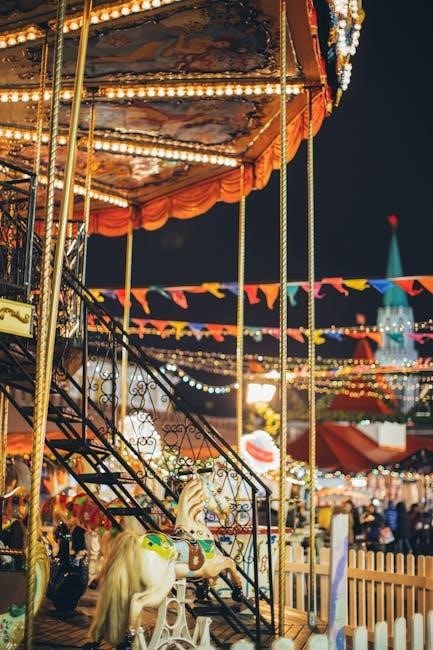“Twas the Night Before Christmas,” also known as “A Visit from St. Nicholas,” is a timeless poem by Clement Clarke Moore, first published in 1822. It has become a cornerstone of Christmas traditions, popularizing imagery like reindeer, stockings, and Santa Claus. This PDF version captures the essence of the original text, offering a nostalgic and magical reading experience. The poem’s enduring appeal lies in its vivid imagery and rhythmic prose, making it a beloved holiday classic for generations.
Overview of the Poem’s Significance
“Twas the Night Before Christmas” holds immense cultural and literary significance, shaping modern Christmas traditions worldwide. Its vivid imagery and rhythmic prose have made it a cherished holiday classic. The poem introduced iconic elements like Santa Claus, reindeer, and stockings, embedding them into global Christmas culture. As a PDF, it remains widely accessible, preserving its timeless charm for digital audiences. Its influence extends beyond literature, becoming a cultural anchor that unites generations. The poem’s enduring popularity highlights its ability to evoke nostalgia and wonder, ensuring its relevance in both traditional and modern contexts of holiday celebration.
Historical Background and Authorship
“Twas the Night Before Christmas,” originally titled “A Visit from St. Nicholas,” was penned by Clement Clarke Moore in 1822. Moore, a scholar and poet, crafted the poem for his children, unaware it would become a cultural phenomenon. The poem’s publication in the Troy, New York, Sentinel marked its entry into the public domain, spreading rapidly across America. Its authorship was initially uncredited, leading to debates over the years, but Moore’s claim is now widely accepted. This PDF version preserves Moore’s original work, offering a glimpse into the poem’s historical roots and its enduring legacy as a holiday staple.
Popularity and Cultural Impact
“Twas the Night Before Christmas” has become a cornerstone of Christmas culture, shaping traditions and imagery worldwide. Its vivid descriptions of reindeer, stockings, and Santa Claus have influenced holiday celebrations and media. The poem’s rhythmic prose and timeless themes have made it a beloved classic, widely read and adapted into films, animations, and stage productions. Its annual readings during the holiday season are a cherished tradition for families. The poem’s popularity endures, with its PDF versions and illustrated editions remaining popular. Its cultural impact is undeniable, sparking debates and inspiring countless reinterpretations, ensuring its relevance across generations and mediums. Its legacy continues to grow, embodying the spirit of Christmas.

Historical Context of the Poem
“Twas the Night Before Christmas,” written by Clement Clarke Moore in 1822, reflects the Christmas traditions of the early 19th century. Its creation in Troy, New York, highlights Moore’s scholarly background and poetic talent, blending holiday customs with literary artistry. The poem’s historical significance lies in its enduring influence on Christmas imagery and traditions, making it a cherished part of cultural heritage. Its publication marked a turning point in popularizing modern Christmas celebrations, ensuring its lasting relevance in literature and history. The poem’s origins and evolution are deeply tied to its historical roots.
Clement Clarke Moore and His Contributions
Clement Clarke Moore, a prominent scholar and poet, wrote “Twas the Night Before Christmas” in 1822, significantly shaping Christmas traditions. Born in 1779, Moore was a professor at the General Theological Seminary in New York, known for his intellectual contributions. His poem, originally titled “A Visit from St. Nicholas,” introduced iconic imagery like Santa Claus, reindeer, and stockings, which became central to holiday culture. Moore’s work not only enriched literature but also influenced modern perceptions of Christmas, solidifying his legacy as a key figure in American cultural history. His contributions endure through the poem’s enduring popularity and timeless appeal.
The Year of Publication and Initial Reception
“Twas the Night Before Christmas” was first published anonymously in 1823 in the Troy, New York, Sentinel. Its immediate popularity led to widespread circulation, and by 1837, Clement Clarke Moore was credited as the author. The poem quickly became a holiday staple, resonating with its vivid imagery and rhythmic style. Its portrayal of Christmas Eve rituals and the magical figure of Santa Claus captivated readers, setting the stage for modern Christmas traditions. The poem’s initial success laid the groundwork for its enduring influence, making it a beloved classic across generations and cultures.
Evolution of the Poem Over Time
Since its debut in 1823, “Twas the Night Before Christmas” has evolved significantly. Initially published anonymously, it gained fame through word of mouth and reprinting in various newspapers. By the mid-19th century, illustrated editions emerged, enhancing its appeal. The poem’s language has been adapted to suit modern audiences, with slight variations in wording while preserving its original charm. Digital versions, including PDFs, have made it accessible worldwide, introducing the classic to new generations. This evolution reflects its timeless themes and adaptability, ensuring its place as a cherished holiday tradition across cultures and technologies.

Cultural Significance of “Twas the Night Before Christmas”

“Twas the Night Before Christmas” holds immense cultural significance, shaping Christmas traditions and imagery worldwide. Its timeless themes of joy, family, and generosity resonate across generations and cultures, making it a universal holiday treasure.
Shaping Christmas Traditions and Imagery
“Twas the Night Before Christmas” profoundly shaped Christmas traditions and imagery, popularizing elements like stockings by the chimney, reindeer names, and Santa Claus’s jolly appearance. Its vivid descriptions of Christmas Eve rituals, such as quiet nights and family gatherings, have become synonymous with holiday celebrations. The poem’s portrayal of Santa and his reindeer-inspired modern depictions in art, literature, and media. Additionally, it influenced traditions like leaving out milk and cookies, creating a sense of magical anticipation. The poem’s imagery has been immortalized in illustrations and adaptations, further cementing its role in shaping cultural perceptions of Christmas worldwide.
The Role of Reindeer, Stockings, and Santa Claus
“Twas the Night Before Christmas” introduced iconic Christmas imagery, including reindeer, stockings, and a jolly Santa Claus. The poem popularized reindeer names like Dasher and Dancer, cementing their role in holiday lore. Stockings hung by the chimney became a tradition, symbolizing anticipation and gift-giving. Santa Claus, described as a cheerful figure in a sleigh, replaced earlier, more austere depictions, shaping modern perceptions. These elements have since influenced Christmas decorations, media, and family practices worldwide, making the poem a cornerstone of holiday traditions. Its imagery continues to inspire festive celebrations and cultural adaptations, ensuring its timeless relevance.
Controversies Surrounding the Poem
The poem “Twas the Night Before Christmas” has faced several controversies. One major debate involves authorship disputes, with some scholars questioning whether Clement Clarke Moore was the true author. Additionally, the poem has been criticized for cultural appropriation, as it reflects the norms of its time, which may now be seen as insensitive. There are also discussions about its religious and secular interpretations, with some arguing it leans too much towards secularism. These debates highlight the poem’s complex legacy and its impact on cultural and social perceptions over time.

Themes and Imagery in the Poem
The poem captures the essence of Christmas through its vivid imagery and themes of family, magic, and tradition, bringing Santa Claus and his reindeer to life in a cozy, timeless setting.
Christmas Eve Rituals and Family Gatherings
The poem vividly portrays Christmas Eve as a time of peaceful anticipation, with “not a creature stirring, not even a mouse.” It captures the quiet moments before Christmas morning, emphasizing family togetherness and the traditional rituals of the season. The imagery of stockings hung by the chimney and the household nestled in slumber evokes a sense of warmth and unity. These scenes reflect the essence of Christmas Eve as a time for reflection, hope, and shared joy, making the poem a beloved part of holiday traditions and family gatherings worldwide.
The Magic of Santa Claus and His Reindeer

The poem immortalizes Santa Claus as a jolly, gift-bringing figure, accompanied by his iconic reindeer. It popularized the image of Santa’s sleigh and reindeer, such as Dasher and Dancer, creating a magical Christmas iconography. The description of Santa’s arrival—”down the chimney St. Nicholas came”—adds to the enchantment. The reindeer, with their supernatural ability to fly, symbolize the fantastical and joyful spirit of Christmas. This imagery has deeply influenced holiday traditions, making Santa and his reindeer central to festive celebrations and imagination, as highlighted in the poem’s enduring popularity and cultural impact. The magic of this scene remains timeless and universally cherished.
The Quiet Night and the Stirring of Life
The poem begins with a serene depiction of Christmas Eve, where “not a creature was stirring, not even a mouse.” This tranquil scene sets the stage for the magical events that follow. The quiet night symbolizes a moment of stillness and anticipation, capturing the essence of Christmas Eve’s special atmosphere. The imagery of a sleeping household contrasts with the sudden arrival of Santa Claus, creating a sense of wonder and surprise. This juxtaposition of stillness and liveliness highlights the poem’s ability to evoke both calm and excitement, making it a cherished holiday tradition.

Educational and Literary Value
“Twas the Night Before Christmas” is widely used in schools and homes for its rich imagery and rhythmic style, making it a valuable tool for teaching language and literature.
Teaching the Poem in Schools and Homes
“Twas the Night Before Christmas” is a popular choice for educational settings, offering rich opportunities for language learning and literary analysis. Teachers often use its rhythmic verse to teach rhyme, meter, and imagery. The poem’s vivid descriptions make it ideal for creative writing exercises, encouraging students to visualize and express holiday themes. In homes, families read it aloud during Christmas Eve rituals, fostering a sense of tradition and togetherness. Its timeless appeal makes it accessible to all age groups, blending entertainment with educational value and helping to preserve holiday spirit across generations;
Language, Style, and Literary Devices
“Twas the Night Before Christmas” showcases Clement Clarke Moore’s mastery of language and literary devices. The poem’s rhythmic verse, written in trochaic tetrameter, creates a musical quality that enhances its storytelling charm. Moore employs vivid imagery, alliteration, and repetition, such as in the famous line, “Not a creature was stirring, not even a mouse.” His use of anaphora in describing Santa Claus adds emphasis and memorable characterization. The archaic yet accessible language contributes to the poem’s timeless appeal, making it a delightful read for both children and adults. These literary techniques ensure the poem’s enduring popularity and educational value.
The Poem’s Appeal to Children and Adults
“Twas the Night Before Christmas” captivates both children and adults with its enchanting imagery and universal themes. For children, the poem’s rhythmic verse, magical descriptions of Santa Claus, and the excitement of Christmas Eve rituals create a sense of wonder. The vivid portrayals of reindeer and the jolly figure of Santa make it a delightful bedtime story. Adults, on the other hand, appreciate the nostalgia and timeless message of joy, family, and generosity. The poem’s simplicity and depth ensure its appeal across generations, making it a cherished holiday tradition for readers of all ages.

Modern Adaptations and Interpretations
The poem’s timeless charm has led to various modern adaptations, including PDF versions for easy digital access, illustrated editions, and creative reinterpretations in media and art, ensuring its enduring relevance.
PDF Versions and Digital Availability
The poem “Twas the Night Before Christmas” is widely available in PDF format, making it easily accessible for digital readers. These versions preserve the original charm while offering convenience for modern audiences. Illustrated editions and annotated PDFs enhance the reading experience, catering to both children and adults. Digital platforms have also made it possible to download and share the poem effortlessly, ensuring its timeless appeal endures in the age of technology. This accessibility has further cemented its place as a holiday staple, allowing new generations to enjoy its magical imagery and festive spirit.
Illustrated Editions and Artistic Interpretations
Illustrated editions of “Twas the Night Before Christmas” have played a significant role in enhancing its appeal. Artists like Thomas Nast and Norman Rockwell have contributed iconic visuals, shaping the modern image of Santa Claus and his reindeer. These illustrations bring the poem’s magical world to life, making it more engaging for readers of all ages. Over the years, various artistic interpretations have been added to the poem, ranging from traditional to modern styles. These visual adaptations not only complement the text but also make the poem more accessible and enjoyable, ensuring its timeless charm endures for future generations.
Modern Retellings and Parodies
Modern retellings and parodies of “Twas the Night Before Christmas” have breathed fresh life into the classic poem. From humorous twists to cultural adaptations, these reinterpretations cater to diverse audiences. Parodies often infuse contemporary themes, such as technology or pop culture, while maintaining the poem’s rhythmic charm. Illustrated children’s versions and animated adaptations have also emerged, making the story more engaging for younger readers. Additionally, digital formats, including interactive PDFs, offer new ways to experience the tale. These creative reinterpretations ensure the poem remains relevant, blending tradition with modern innovation to captivate both new and lifelong fans of the holiday classic.

Historical Controversies and Debates
Authorship disputes and claims of cultural appropriation have long surrounded the poem, with debates over its origins and representation of Christmas traditions sparking ongoing discussions and scholarly arguments.
Authorship Disputes and Claims
Clement Clarke Moore is traditionally credited with writing “Twas the Night Before Christmas” in 1822, but debates over its authorship have persisted. Some scholars argue that Henry Livingston Jr. may have contributed or even authored the poem, citing stylistic similarities to his other works. Moore’s daughter produced the original manuscript in 1844 to solidify his claim, yet doubts remain. These disputes highlight the poem’s complex origins and the challenges of attributing creative works from the 19th century. The debate continues to intrigue scholars and literary enthusiasts, adding layers to the poem’s historical significance.
Cultural Appropriation and Representation
“Twas the Night Before Christmas” has faced criticism for its portrayal of cultural elements, with some arguing that it oversimplifies or excludes diverse traditions. The poem reflects 19th-century attitudes, which may not align with modern sensitivities. Critics point to the lack of representation of non-Western cultures and the potential for stereotyping in its imagery. Despite this, modern adaptations strive to address these issues, offering more inclusive interpretations. The debate highlights the challenge of balancing historical context with contemporary values, ensuring that cultural elements are respectfully represented rather than appropriated.
Religious and Secular Interpretations
“Twas the Night Before Christmas” blends religious and secular themes, making it accessible to diverse audiences. While it references Christmas traditions, the poem focuses more on familial joy and Santa Claus than overtly religious imagery. This balance allows it to resonate with both religious and secular readers. Some interpret the poem as a celebration of Christmas spirit without religious doctrine, while others see it as a reflection of the holiday’s origins. The poem’s subtle approach to faith has helped it remain a universal favorite, bridging cultural and belief-based divides for nearly two centuries.

The Poem’s Legacy in Popular Culture
“Twas the Night Before Christmas” has profoundly influenced popular culture, inspiring countless adaptations in films, music, and literature. Its imagery and themes are annually celebrated in readings and events, ensuring its lasting impact on holiday traditions worldwide.
References in Films, Music, and Literature
“Twas the Night Before Christmas” has inspired countless adaptations across media. Films like The Polar Express and Miracle on 34th Street draw on its imagery, while songs like “Rudolph the Red-Nosed Reindeer” reflect its themes. Literature often references the poem, with parodies and reinterpretations appearing in holiday stories. Its iconic lines, such as “not a creature was stirring,” are frequently quoted in popular culture. The poem’s influence extends to holiday specials, cartoons, and even comedy sketches, cementing its role as a cultural touchstone. Its enduring presence in media ensures its legacy continues to resonate with new generations, making it a cornerstone of Christmas storytelling.
Memorabilia, Merchandise, and Collectibles
“Twas the Night Before Christmas” has inspired a wide range of memorabilia and merchandise, from illustrated editions to festive ornaments. Limited-edition prints, vintage posters, and collector’s items featuring the poem’s imagery are highly sought after. The poem’s themes are also reflected in holiday-themed products like stockings, reindeer figurines, and Santa Claus decorations. Rare first editions and signed copies of the poem are prized by collectors. Additionally, themed gifts, such as plush toys and holiday cards, bring the poem’s magic to life. These items not only celebrate the poem’s legacy but also make it a part of holiday traditions and personal collections worldwide.
Annual Readings and Community Events
Annual readings of “Twas the Night Before Christmas” have become a beloved holiday tradition in many communities. Libraries, schools, and cultural organizations often host special events where the poem is recited by actors or community leaders. These gatherings frequently include festive activities, such as caroling, craft workshops, and visits from Santa Claus. In Troy, New York, the poem’s historical connection is celebrated with annual readings and reenactments. Many events also incorporate interactive elements, like audience participation or Q&A sessions, to engage attendees. These traditions not only honor the poem’s legacy but also foster a sense of community and holiday spirit worldwide.
“Twas the Night Before Christmas” remains a timeless holiday classic, inspiring joy and nostalgia across generations. Its enduring appeal lies in its ability to evoke warmth and tradition, while its PDF versions ensure accessibility for modern readers. The poem’s legacy endures, shaping Christmas spirit and fostering a sense of community through annual readings and celebrations. As it continues to adapt to the digital age, its message of hope and joy remains a cherished part of global holiday traditions.
Enduring Appeal and Timeless Message
“Twas the Night Before Christmas” continues to captivate readers with its universal themes of joy, family, and wonder. Its vivid imagery and rhythmic prose transcend generations, making it a beloved holiday tradition. The poem’s timeless message of hope and joy resonates deeply, adapting seamlessly to modern formats like PDFs, ensuring its accessibility to new audiences. Its enduring appeal lies in its ability to evoke nostalgia while remaining relevant, a testament to its cultural significance. As a digital-age classic, it continues to inspire holiday spirit, reminding us of the magic and warmth that define Christmas.
The Poem’s Role in Shaping Christmas Spirit
“Twas the Night Before Christmas” has profoundly influenced the way people envision and celebrate Christmas. By popularizing imagery such as Santa Claus, reindeer, and stockings, the poem has become a cornerstone of holiday traditions. Its vivid depiction of a magical Christmas Eve has shaped cultural perceptions, creating a sense of wonder and joy. The poem’s ability to evoke nostalgia and warmth has made it a unifying force during the holiday season. Its enduring legacy ensures that it continues to inspire festive spirit, fostering a sense of community and shared celebration. Its impact remains unparalleled in defining the modern Christmas experience.
Future of the Poem in the Digital Age
The “Twas the Night Before Christmas” poem is thriving in the digital age, with its PDF versions widely accessible online. This format ensures the poem reaches new generations, preserving its timeless charm. Digital platforms allow for interactive and illustrated editions, enhancing engagement. Audiobook versions and animations further expand its appeal. As technology advances, the poem may incorporate augmented reality or immersive storytelling. Its adaptability ensures it remains relevant, spreading joy and festive spirit globally. The PDF format, alongside other digital innovations, guarantees the poem’s enduring presence in a rapidly evolving world, keeping its magic alive for future readers.